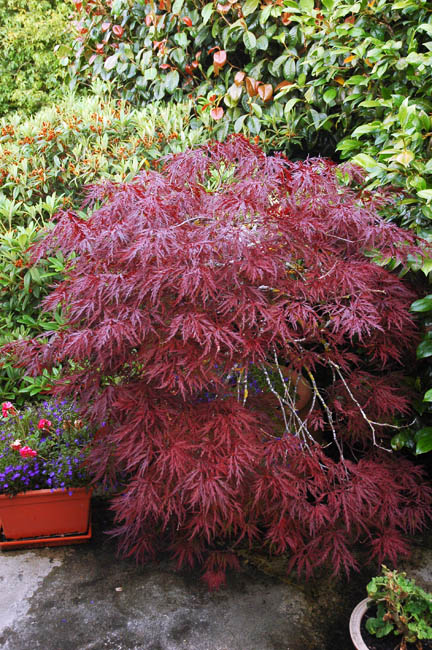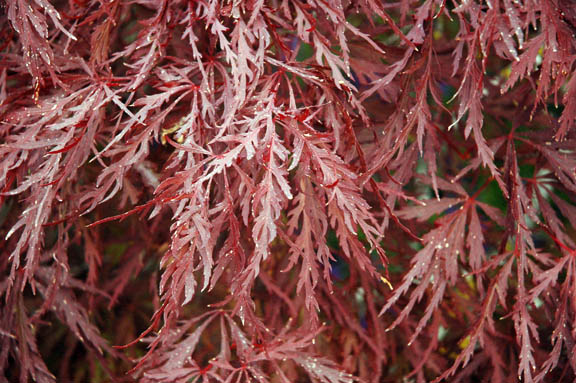
Woody > Acer > Acer palmatum > Acer palmatum 'Dissectum Rubrum'
Acer palmatum
'Dissectum Rubrum'
Red Cutleaf Japanese Maple
Origin: Introduced in Great Britain in 1875.
Mike's
Opinion


"
Acer palmatum var.dissectum 'Rubrum's' compact, mounding shape make it an ideal tree for a small garden. It is great as an accent tree planted in a sheltered area. It is quite hardy and not as fragile as it may seem based on its delicate foliage. I find this cultivar to be quite interesting and artistic with its delicate foliage, contorted branching habit and its alluring year round coloured foliage, a reddish green foliage, transforming into a vibrant orange in the autumn.
Michael Pascoe, NDP., ODH., CLT., MSc. (Plant Conservation)
"
| Family |
| Sapindaceae (Aceraceae) |
| Genus |
| Acer |
| Species |
| palmatum |
| Cultivar |
| 'Dissectum Rubrum' |
| Category |
| Woody |
| Type |
| Tree (deciduous) |
| USDA Hardiness Zone |
| 5 |
| Canadian Hardiness Zone |
| 4 - 6a |
| RHS Hardiness Zone |
| H7 |
| Temperature (°C) |
| -29 - (-23) |
| Temperature (°F) |
| -20 - (-10) |
| Height |
| 3 m |
| Spread |
| 3 m |
Photographs
Description and Growing Information
Flowering Period
| General Description |
| A specimen that is small, yet hardy slow growing tree. It forms a mushroom to dome-like shape with finely cut foliage. |
| Landscape |
| Often used in small gardens as a focal point. They can also can be grown in a large container, and are great for bonsai. Ideal for patio, low maintenance and woodland gardens. They are also a choice specimen to plant near a pool, so that the artistic form of the branches may reflect in the water. It is best planted in a sheltered location. |
| Cultivation |
| It can tolerate full sun or partial shade, although it seems to thrive in dappled shade. Well drained, fertile soil that has a neutral to acidic level is recommended for this cultivar. It requires some shelter from strong winds, as this can scorch the leaves. |
| Shape |
| This cultivar has a neat and compact mounding form with ascending branches. |
| Growth |
| Slow |
| ID Characteristic |
| Filigree like foliage, vibrant autumn colour and attractive contorted and twisted branches, are the main defining characteristics of this cultivar. They also have lovely tiny reddish-purple flowers when in bloom. |
| Pests |
| Aphids and horse chestnut scale are the main pests that can affect this cultivar. It is also susceptible to verticillium wilt. Their delicate leaves may also be damaged by a late frost in the early spring or wind and sunburn if planted in exposed locations. |
| Habitat |
| Horticultural origin. |
| Bark/Stem Description |
| Smooth grey bark. It has a very attractive branching form that creates winter interest. |
| Flower/Leaf Bud Description |
| The opposite buds are cone-like shaped and chestnut in colour. |
| Leaf Description |
| Palmate leaf, delicate, lace-like, deeply cut, 5 - 9 lobes. |
| Flower Description |
| Small, yet attractive red-purple coloured flowers. |
| Fruit Description |
| A feathered, vigorously veined, two winged smara develops after the plant flowers in June. |
| Colour Description |
| Beautiful colour in spring, summer and autumn. Transforming from a reddish-green in the spring and summer to a vibrant orange in the autumn. |
| Texture Description |
| Fine textured. |
| Notable Specimens |
| The A. M. Cuddy Gardens, Strathroy, Ontario, Canada. |
| Propagation |
| This tree should be propagated by grafting. Since their delicate twigs grow down rather than upward, they are grafted onto a standard. The height of the standard understock it is grafted to determines the ultimate height of the tree. |
References
Toomer, S. (2005). Trees for the small garden: How to choose, plant, and care for the tree that makes the garden special (pp. 28-30).
Portland, Or.: Timber Press. Dirr, M. (1997). Dirr's hardy trees an illustrated encyclopedia (p. 21, 450). Portland, OR: Timber Press.

